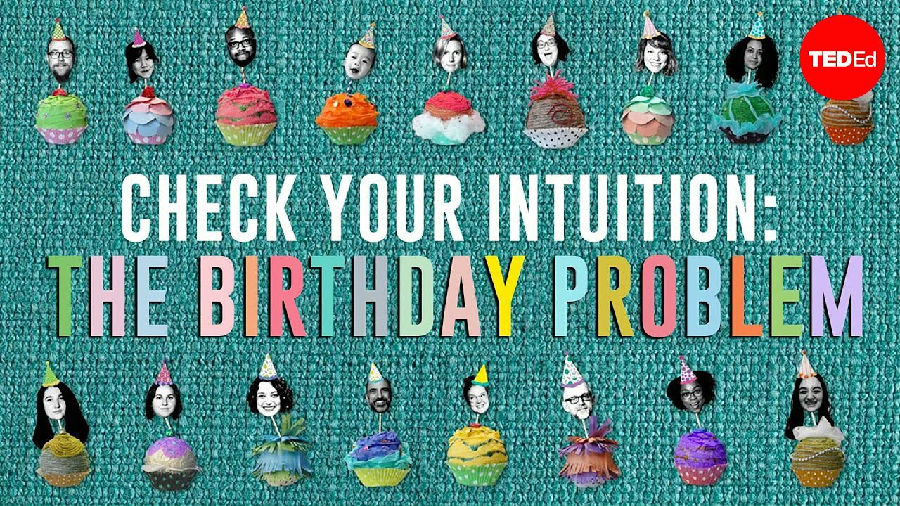(单词翻译:单击)
Imagine a group of people. How big do you think the group would have to be
设想有一组人。当人数达到多少时,
before there's more than a 50% chance that two people in the group have the same birthday?
其中两人生日相同的概率会超过50%?
Assume for the sake of argument that there are no twins, that every birthday is equally likely, and ignore leap years.
假设这人群中没有双胞胎,所有人的生日概率都相等,并且排除掉闰年的存在。
Take a moment to think about it. The answer may seem surprisingly low.
花一点时间想想。所需要的人数其实是相当少的。
In a group of 23 people, there's a 50.73% chance that two people will share the same birthday.
若一组有23个人,那么两个人有相同生日的概率是50.73%。
But with 365 days in a year, how's it possible that you need such a small group to get even odds of a shared birthday?
但一年有365天这么多天,为什么只需要这么少的人就可以使其中两人生日相同?
Why is our intuition so wrong?
为什么我们的直觉是如此错误的?
To figure out the answer, let's look at one way a mathematician might calculate the odds of a birthday match.
为了找到答案,让我们看看数学家是如何计算生日相同的概率的。
We can use a field of mathematics known as combinatorics, which deals with the likelihoods of different combinations.
我们可以使用组合数学的分析方法,它用来计算不同组合的概率。
The first step is to flip the problem.
首先我们需要转换问题。
Trying to calculate the odds of a match directly is challenging
直接计算生日相同的概率是很困难的,
because there are many ways you could get a birthday match in a group.
因为二人相同的生日可能是在任一天。
Instead, it's easier to calculate the odds that everyone's birthday is different. How does that help?
相反,计算每个人生日不同的概率是更简单的。这对于问题有什么帮助呢?
Either there's a birthday match in the group, or there isn't,
一组人中,要么有两人生日相同,要么没有,
so the odds of a match and the odds of no match must add up to 100%.
所以这两种情况的概率相加必然等于100%。
That means we can find the probability of a match by subtracting the probability of no match from 100.
这意味着我们可以通过将无相同生日的概率从100%中减去,而得到有相同生日的概率。
To calculate the odds of no match, start small.
让我们先考虑简单情况。
Calculate the odds that just one pair of people have different birthdays.
先从只有一对人拥有不同生日开始。
One day of the year will be Person A's birthday, which leaves only 364 possible birthdays for Person B.
假定对象A的生日是某天,那么对象B的生日就是其余364天之一。
The probability of different birthdays for A and B, or any pair of people, is 364 out of 365,
对象A和B或是任何两人生日不同的概率就是364/365,
about 0.997, or 99.7%, pretty high. Bring in Person C.
大约是99.7%,非常高的概率。我们再引入对象C。

The probability that she has a unique birthday in this small group is 363 out of 365
她和其他人生日都不同的概率是363/365,
because there are two birthdates already accounted for by A and B.
因为已经有两个日期被对象A和B占用。
D's odds will be 362 out of 365, and so on, all the way down to W's odds of 343 out of 365.
对象D不与他人生日相同的概率是362/365,以此类推,到对象W是概率为343/365。
Multiply all of those terms together, and you'll get the probability that no one shares a birthday.
将这些数字相乘,就会得到没有人生日相同的概率。
This works out to 0.4927, so there's a 49.27% chance that no one in the group of 23 people shares a birthday.
结果是0.4927,所以23人当中,大家生日都不同的概率是49.27%。
When we subtract that from 100, we get a 50.73% chance of at least one birthday match, better than even odds.
再用100%减去这个数值,就得到50.73%,这就是至少有两个人生日相同的概率,已经超过了50%。
The key to such a high probability of a match in a relatively small group is the surprisingly large number of possible pairs.
在人数如此少的小组中出现高概率,其关键在于可能的组合数量巨大。
As a group grows, the number of possible combinations gets bigger much faster.
随着人数增加,可能出现的组合数量会快速增加。
A group of five people has ten possible pairs.
5人当中就有10种不同的组合方式。
Each of the five people can be paired with any of the other four.
五个人的任何一人都可以和其他四人构成组合。
Half of those combinations are redundant
其中一半是重复计算,
because pairing Person A with Person B is the same as pairing B with A, so we divide by two.
因为对象A+对象B的组合与对象B+对象A相同,所以我们将数字除以2。
By the same reasoning, a group of ten people has 45 pairs, and a group of 23 has 253.
相同的道理,10个人当中就会出现45对组合,23人当中会有253对组合。
The number of pairs grows quadratically, meaning it's proportional to the square of the number of people in the group.
组合的数量成倍增加,即以小组人数的基数的成比例增长。
Unfortunately, our brains are notoriously bad at intuitively grasping non-linear functions.
不幸的是,我们的大脑非常不擅长直接处理非线性函数。
So it seems improbable at first that 23 people could produce 253 possible pairs.
所以23人就有253种配对组合看上去是不可能的。
Once our brains accept that, the birthday problem makes more sense.
一旦明白了这个道理,生日问题就变得合理了。
Every one of those 253 pairs is a chance for a birthday match.
253对组合中的人都能找到生日相同的另一半。
For the same reason, in a group of 70 people, there are 2,415 possible pairs,
同样的,在70个人构成的小组中,组合数量能达到2415个,
and the probability that two people have the same birthday is more than 99.9%.
两个人拥有相同生日的概率超过了99.9%。
The birthday problem is just one example where math can show that things that seem impossible,
生日问题是一个很好的例子,展示出数学可以解释看起来不可能的事情,
like the same person winning the lottery twice, actually aren't unlikely at all.
例如同一个人中两次彩票,不是几乎不可能的。
Sometimes coincidences aren't as coincidental as they seem.
有时巧合并没有看上去那么巧。


